2020-2021 PREDATORS: EXTINCT by AllCollect
An interesting, if pricey addition to the limited mintage silver bullion market, AllCollect’s ‘Predator’ series was an eclectic mix of subjects from the natural world, brought to life with a mix of finishes on the same face. As you know, we love the prehistoric world here, so this newer companion series is off to a flying start, It’s great to see some real effort put into each design, as well as the eschewing of all the usual subjects for some rarer ones. Sure, there’s a Spinosaurus and a Megalodon, but there’s also the ‘Terror Bird’, the chicken from hell!, and a mix of mammals and reptiles, both terrestrial and marine. The DNA taken from the original series is evident, but these are a bit more polished to my eye.
There’s a common arcing section to the bottom left replete with fossils, and the coin title sits squarely on top, but the rest is unique to each issue. Pride of place is taken by the subject, each looking correct, with the Spinosaurus neatly sidestepping the latest theories on the tail and the habitat by just showing the front of this absolutely huge predator. A piece of fossil evidence is dropped onto the boundary area between background and midground areas – a tooth, or a skull. All the designs exhibit a good sense of anatomy.
Rarer than ‘Predators’ with a mintage of just 5,000 pieces per design, it does have the unfortunate effect of making these quite pricey for a bullion coin. The obverse has the attractive emblem of the issuing nation, the Democratic Republic of the Congo. Formerly known as Zaire, the DRC is actually the eleventh largest country in the world by surface area.
Just the 1 oz silver variant at present, the earlier ‘Predators’ series has expanded to include a 0.5 gram minigold, and a chromite/gilded silver version. Whether that happens here as well is unknown at present, and will no doubt be left to the vagaries of the German TV shopping market, who have a strange attraction to numismatics. At the time of writing, there are now 16 coins out (8 in 2020, 8 in 2021), and as usual, we’ll keep this profile up to date with new issues. A really nice series, but you’ll have to dig a bit deeper for them.
2020 Spinosaurus (Spinosaurus aegyptiacus)
First described by the German paleontologist Ernst Stromer in 1915 from remains found in North Africa in 1912, Spinosaurus (‘spine lizard’) lived in the Cretaceous period from around 112 to 97 million years ago. A theropod dinosaur, these huge carnivorous creatures are still relatively unknown due to the sparsity of fossil remains found to date, but their remarkable nature is clear to see.
Estimated to have grown up to 18m in length and weigh 20 tonnes, there’s been much recent speculation over its semi-aquatic lifestyle.
With the long and narrow skull of a crocodilian, Spinosaurus was predominently a fish-eater and lived both on land and in water as a modern crocodilian does. The distinctive spines of Spinosaurus, which were long extensions of the vertebrae, grew to at least 1.65m long and were likely to have had skin connecting them, forming a sail-like structure, although some authors have suggested that the spines were covered in fat and formed a hump. Multiple functions have been put forward for this structure, including thermoregulation and display.
2020 Megalodon (Otodus megalodon)
With a name that literally means ‘Big Tooth’, Megalodon is considered one of the biggest predators in the planets’ history. It lived approximately 23 to 3.6 million years ago (MYA), during the Early Miocene to the Pliocene
Most estimates, extrapolated from teeth, put the maximum length at 14.2–16 meters and average length at 10.5 meters. It’s suggested their jaws could exert a bite force of up to 108,500 to 182,200 newtons (24,400 to 41,000 LBF). Their teeth were thick and robust, built for grabbing prey and breaking bone.
The fossil record indicates that it had a cosmopolitan distribution. It probably targeted large prey, such as whales, seals and sea turtles.
Juveniles inhabited warm coastal waters and fed on fish and small whales. Unlike the great white, which attacks prey from the soft underside, Megalodon probably used its strong jaws to break through the chest cavity and puncture the heart and lungs of its prey.
2020 Mosasaurus (Mosasaurus hoffmannii)
Living through the Late Cretaceous period (82-66 mya), the aquatic reptile Mosasaurus, was an apex predator, growing up to an estimated 17.6 meters in length.
Its skull was equipped with robust jaws capable of swinging back and forth and strong muscles capable of powerful bites using dozens of large teeth designed for cutting prey. Its four limbs were shaped into robust paddles to steer the animal underwater. Its tail was long and ended in a paddle-like fluke that bent downwards.
Mosasaurus was a predator that had excellent vision to compensate for its poor sense of smell, and a high metabolic rate that suggests it was warm-blooded.
Fossil evidence suggests that Mosasaurus inhabited much of the Atlantic Ocean and the seaways adjacent to it. Scientists believe that its diet would have included virtually any animal; it likely preyed on bony fish, sharks, cephalopods, birds, and other marine reptiles including sea turtles and other mosasaurs. It likely preferred to hunt in open water near the surface.
2020 Phorusrhacidae (Phorusrhacos longissimus)
Colloquially known as terror birds, these carnivorous flightless birds were the largest species of apex predators in South America during the Cenozoic era; their conventionally accepted temporal range covers from 62 to 1.8 mya.
They ranged in height from 1 to 3 m and scientists theorise that the larger species were extremely nimble and quick runners, able to reach speeds of 48 km/h. All members possessed a large, sharp beak, a powerful neck and sharp
talons. However, even with these attributes, the phorusrhacids are often assumed to have preyed on relatively small animals (rabbit sized) that could be dispatched with minimum struggle.
The bones of the beak were tightly fused together, making the beak more resilient to force from the front to back direction, suggesting it could cause great harm through pecking as opposed to side-to-side head movements like shaking prey. Generally speaking, it is thought that a terror bird would use its feet to injure prey by kicking it, and to hold the prey down and dispatch by pecking at it with its large beak.
2020 Smilodon (Smilodon populator)
One of the most iconic prehistoric mammals, the Smilodon is best known as the Sabre-toothed Tiger, despite not being closely related to any modern species. It lived in the Americas during the Pleistocene epoch (2.5 MYA – 10,000 years ago).
More robustly built than any extant cat, with particularly well-developed forelimbs and exceptionally long upper canine teeth, its jaw had a bigger gape than that of modern cats, and its upper canines were slender and fragile, adapted for precision killing.
Of the three known species, S. populator from South America was the largest, weighing 220 to 436 kg, and up to 1.2 m tall. In North America, Smilodon hunted large herbivores such as bison and camels, and is thought to have killed its prey by holding it still with its forelimbs and biting it.
Scientists debate whether Smilodon had a social or a solitary lifestyle;, but it probably lived in closed habitats such as forests and bush, which would have provided cover for ambushing prey.
2020 Marsupial Lion (Thylacoleo Carnifex)
Thylacoleo (“pouch lion”) was a carnivorous marsupial that lived in Australia from the late Pliocene to the late Pleistocene (2 million to 46 thousand years ago). Some of these marsupial lions were the largest mammalian predators in Australia of their time, approaching the weight of a lioness. The estimated average weight ranges from 101 to 130 kg. Thylacoleo was 75 cm at the shoulder and about 150 cm long from head to tail.
Pound for pound, Thylacoleo carnifex had the strongest bite of any mammal species, living or extinct; one weighing 101 kg had a bite comparable to that of a 250 kg African lion, and research suggests that it could hunt and take prey much larger than itself. Larger animals that were likely prey include Diprotodon spp. and giant kangaroos. It also had extremely strong fore limbs, with retractable, cat-like claws, a trait previously unseen in marsupials. Thylacoleo also possessed enormous hooked claws set on large semi-opposable thumbs, which were used to capture and disembowel prey.
Its strong forelimbs, retracting claws, and incredibly powerful jaws mean that Thylacoleo possibly climbed trees and perhaps carried carcasses to keep the kill for itself (similar to the leopard today).
2020 Falkland Islands Wolf (Dusicyon Australis)
The Falkland Islands wolf was the only native land mammal of the Falkland Islands. It became extinct in 1876, the first known canid to have become extinct in historical times.
The Falkland Islands wolf existed on both West and East Falkland, but Charles Darwin was uncertain if they were differentiated varieties or subspecies.
Its fur had a tawny colour and the tip of the tail was white. Its diet is unknown, but, due to the absence of native rodents on the Falklands, probably consisted of ground-nesting birds, such as geese and penguins, seal pups, and insects, as well as seashore scavenging. It has sometimes been said that it may have lived in burrows.
An Ice Age land bridge or ice connection between the Falkland Islands and South America, enabling the species’ ancestors to traverse the gap, has long been suggested. It seems likely that the founding population of the wolf crossed on this ice bridge during the last Ice Age.
2020 Megalania (Varanus Priscus)
Megalania was a species of giant monitor lizard, part of the megafaunal assemblage that inhabited Australia during the Pleistocene. It is the largest terrestrial lizard known to have existed, reaching an estimated length of 3.5 to 7 metres, and weighing between 97–1,940 kg, but the fragmentary nature of known remains make estimates highly uncertain.
Megalania is thought to have had a similar ecology to the living Komodo dragon. The youngest fossil remains of giant monitor lizards in Australia date to around 50,000 years ago. The first indigenous settlers of Australia might have encountered Megalania, and been a factor in their extinction.
Judging from its size, it would have fed mostly upon medium- to large-sized animals, including any of the giant marsupials such as Diprotodon, along with other reptiles and small mammals, as well as birds and their eggs and chicks. It had heavily built limbs and body, a large skull complete with a small crest between the eyes, and a jaw full of serrated, blade-like teeth. Being a member of Anguimorpha, Megalania may have been venomous and if so, would be the largest venomous vertebrate known.[
2021 Rodrigues Giant Day Gecko (Phelsuma Gigas)
The Rodrigues giant day gecko is an extinct species of day gecko. It lived on the island of Rodrigues and surrounding islands and typically dwelt on trees. The Rodrigues giant day gecko fed on insects and nectar, and, unlike most other day geckos, was apparently nocturnal in habit.
Phelsuma gigas was one of the largest known geckoes. It reached a total length of about 40 cms. The body colour was greyish or greyish brown and on the back there were irregular black spotting. The tail had some striping and was charcoal- or dark grey-coloured. The tongue had a pink colour and the ventral side of the body was light yellow. The original collected specimens that were used to describe this species have been lost. Today, only a few portions of some skeletons remain.
P. gigas was an arboreal lizard living on trees within the forests of Rodrigues. These day geckos fed on various insects and other invertebrates. As observed in other species of day geckos, it was assumed that P. gigas also liked to lick at soft, sweet fruit, pollen and nectar.
2021 Giant Belemnite(Megateuthis Gigantea)
Megateuthis gigantea is the largest known belemnite species, reaching about 50 mm in maximum diameter and 700 mm in length of rostrum. The fossil remains were discovered in Europe and Asia.
Belemnitida is an extinct order of squid-like cephalopods that existed from the Late Triassic to Late Cretaceous. Unlike squid, belemnites had an internal skeleton that made up the cone. The calcitic guard is the most common remain. Belemnites, in life, are thought to have had 10 hooked arms and a pair of fins on the guard. The chitinous hooks were usually no bigger than 5 mm, though a belemnite could have had between 100 and 800 hooks in total, using them to stab and hold onto prey.
They were an important food source for many Mesozoic marine creatures, both the adults and the planktonic juveniles, and likely played an important role in restructuring marine ecosystems after the Triassic–Jurassic extinction event. They may have laid between 100 and 1,000 eggs. Some species may have been adapted to speed and swam in the turbulent open ocean, whereas others resided in the calmer littoral zone and fed off the seafloor.
2021 Cave Bear (Ursus Spelaeus)
The Falkland Islands wolf was the only native land mammal of the Falkland Islands. It became extinct in 1876, the first known canid to have become extinct in historical times.
The Falkland Islands wolf existed on both West and East Falkland, but Charles Darwin was uncertain if they were differentiated varieties or subspecies.
Its fur had a tawny colour and the tip of the tail was white. Its diet is unknown, but, due to the absence of native rodents on the Falklands, probably consisted of ground-nesting birds, such as geese and penguins, seal pups, and insects, as well as seashore scavenging. It has sometimes been said that it may have lived in burrows.
An Ice Age land bridge or ice connection between the Falkland Islands and South America, enabling the species’ ancestors to traverse the gap, has long been suggested. It seems likely that the founding population of the wolf crossed on this ice bridge during the last Ice Age.
2021 Titanoboa (Titanoboa Cerrejonensis)
Titanoboa is an extinct genus of very large snakes that lived in what is now La Guajira in northeastern Colombia. They could grow up to 12.8 m, perhaps even 14.3 m long and reach a weight of 1,135 kg. This snake lived during the Middle to Late Paleocene epoch, around 60 to 58 million years ago, following the extinction of the dinosaurs.
Although originally thought to be an apex predator, the discovery of skull bones revealed that it was more than likely specialized in preying on fish. The only known species is Titanoboa cerrejonensis, the largest snake ever discovered, which supplanted the previous record holder, Gigantophis garstini.
Due to the warm and humid greenhouse climate of the Paleocene, the region of what is now Cerrejón was covered by wet tropical rainforests that covered coastal plains that housed large river systems, which were inhabited by various freshwater animals, especially reptiles.
2021 Tasmanian Tiger (Thylacinus Cynocephalus)
The thylacine is an extinct carnivorous marsupial that was native to the Australian mainland and the islands of Tasmania and New Guinea. The last known live animal was captured in 1930 in Tasmania. It is commonly known as the Tasmanian tiger (because of its striped lower back) or the Tasmanian wolf (because of its canid-like characteristics).
The thylacine was relatively shy and nocturnal, with the general appearance of a medium-to-large-size canid, except for its stiff tail and abdominal pouch similar to that of a kangaroo. Because of convergent evolution, it displayed an anatomy and adaptations similar to the tiger and wolf of the Northern Hemisphere, such as dark transverse stripes that radiated from the top of its back, and a skull shape extremely similar to those of canids, despite being unrelated.
The thylacine was a formidable apex predator, though exactly how large its prey animals were is disputed. The thylacine was one of only two marsupials known to have a pouch in both sexes. The mature thylacine ranged from 100 to 130 cm long, plus a tail of 50 to 65 cm. Adults stood about 60 cm at the shoulder and weighed 12 to 22 kg, though they could range anywhere from 8 to 30 kg.
2021 Eurypterid (Pterygotus Anglicus)
Pterygotus is a genus of giant predatory eurypterid, a group of extinct aquatic arthropods. Fossils of Pterygotus have been discovered in deposits ranging in age from Middle Silurian to Late Devonian, and fossils have been recovered from four continents; Australia, Europe, North America and South America, suggesting a worldwide distribution.
Pterygotus was among the largest eurypterids. Isolated fossil remains of a large chelicera (frontal appendage) suggests that they reached a body length of 1.75 metres. Pterygotus was surpassed in size by other giant eurypterids, with Acutiramus able to surpass 2 metres, and Jaekelopterus as much as 2.6 metres.
Like its close relative Jaekelopterus, Pterygotus was a large and active predator, noted for its robust and enlarged cheliceral claws that would have allowed it to puncture and grasp prey, and a visual acuity comparable to that of modern predatory arthropods.
2021 Basal Pinniped (Puijila Darwini)
Puijila darwini is an extinct species of basal pinniped (sea)which lived during the Miocene epoch about 21 to 24 million years ago. Approximately a metre in length, the animal possessed only minimal physical adaptations for swimming. Unlike modern pinnipeds, it did not have flippers and its overall form was otter-like, albeit more specialized; its skull and teeth are the features that most clearly indicate that it is a seal. It is considered to be the most primitive pinniped yet found.
Its fossil remains demonstrate the presence of enlarged, probably webbed feet, robust forelimbs and an unspecialized tail.
The fossil was discovered in 2007 at an early Miocene lake deposit of the Haughton Formation of Devon Island in Nunavut, Canada. The palaeobotanical record suggests that the lake comprised a forest community transitional between a boreal and a conifer–hardwood forest, in a cool temperate, coastal climate with moderate winters. Puijila darwini is the first mammalian carnivore found in the Haughton lake deposits. This also gives an indication that the entire pinniped family may have originated in the Arctic.
2021 Pteranodon (Pteranodon Longiceps)
Pteranodon is a genus of pterosaur that included some of the largest known flying reptiles, with wingspans over 7 meters. They lived during the late Cretaceous period of North America. More fossil specimens of Pteranodon have been found than any other pterosaur, with about 1,200 specimens known to science, many of them well-preserved with nearly complete skulls and articulated skeletons.
Pteranodon was a pterosaur, meaning that it isn’t a dinosaur, but were the largest flying animals known until the late 20th century, when the giant azhdarchid pterosaurs were discovered. The wingspan of an average adult male was 5.6 meters, with females averaging 3.8 meter. The wing shape of Pteranodon suggests that it would have flown rather like a modern-day albatross.
Pteranodon had toothless beaks, similar to those of birds, made of solid, bony margins that projected from the base of the jaws. The beaks were long, slender, and ended in thin, sharp points. The most distinctive characteristic of Pteranodon is its cranial crest, consisting of skull bones projecting upward and backward from the skull. The diet of Pteranodon is known to have included fish.
COMMON OBVERSE
The same obverse as the prior ‘Predators’ series, there’s a border that holds the inscribed issuing country, and the denomination of 20 Francs (CFA).
The coat of arms of the Democratic Republic of the Congo is one that has changed quite a few times, with the latest version having its origins in 2006 under the rule of President Joseph Kabila.
It depicts a leopard head, surrounded by an elephant tusk to the left and a spear to the right. Below are the three words which make up the national motto: Justice, Paix, Travail (Justice, Peace, Work in French).
SPECIFICATION
| PREDATORS: EXTINCT |
|
| DENOMINATION | 20 Francs CFA (Congo) |
| COMPOSITION | 0.999 silver |
| WEIGHT | 31.1 grams |
| DIMENSIONS | 38.61 mm |
| FINISH | Brilliant uncirculated |
| MINTAGE | 5,000 per design |
| BOX / C.O.A. | No / Mo |


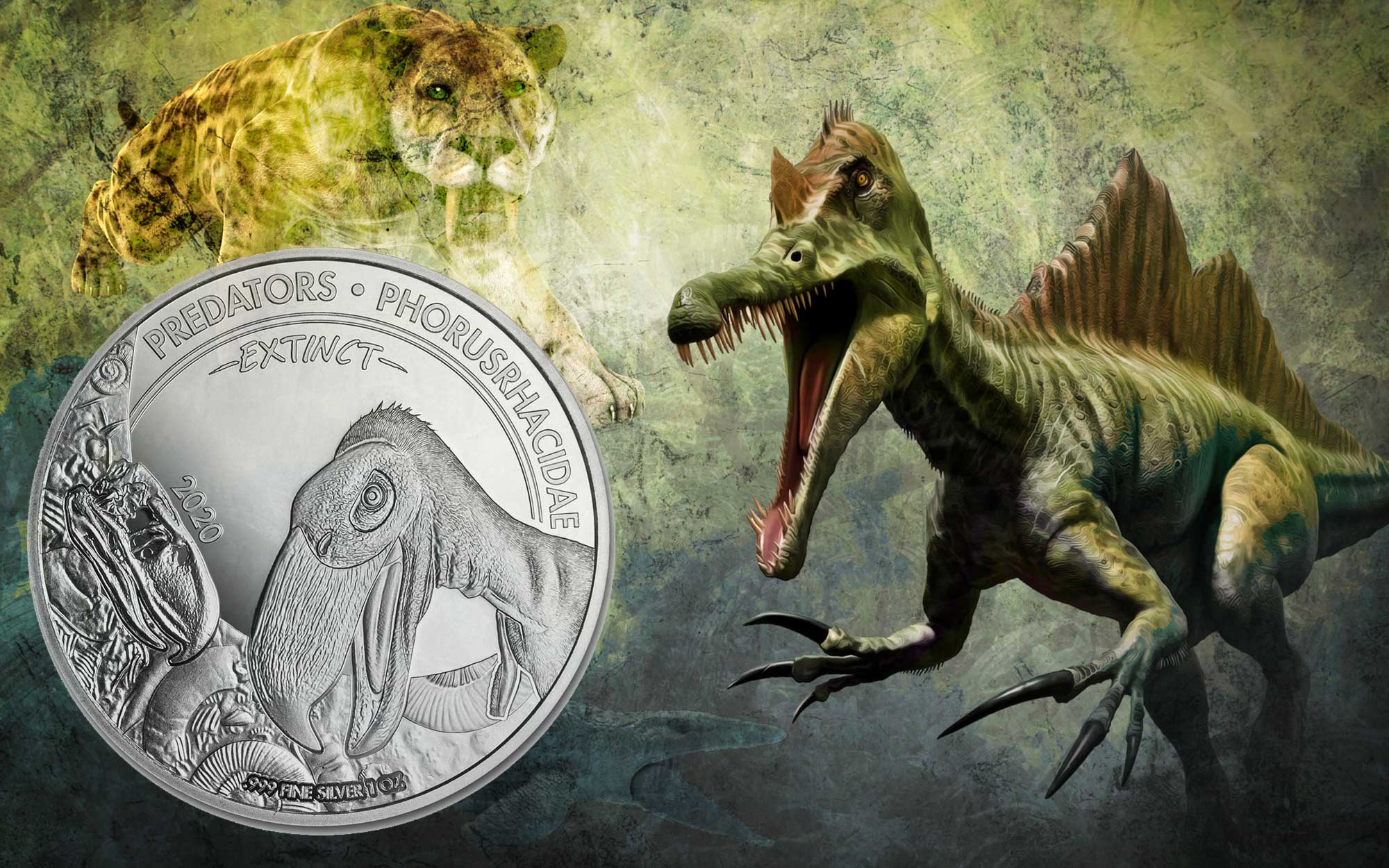



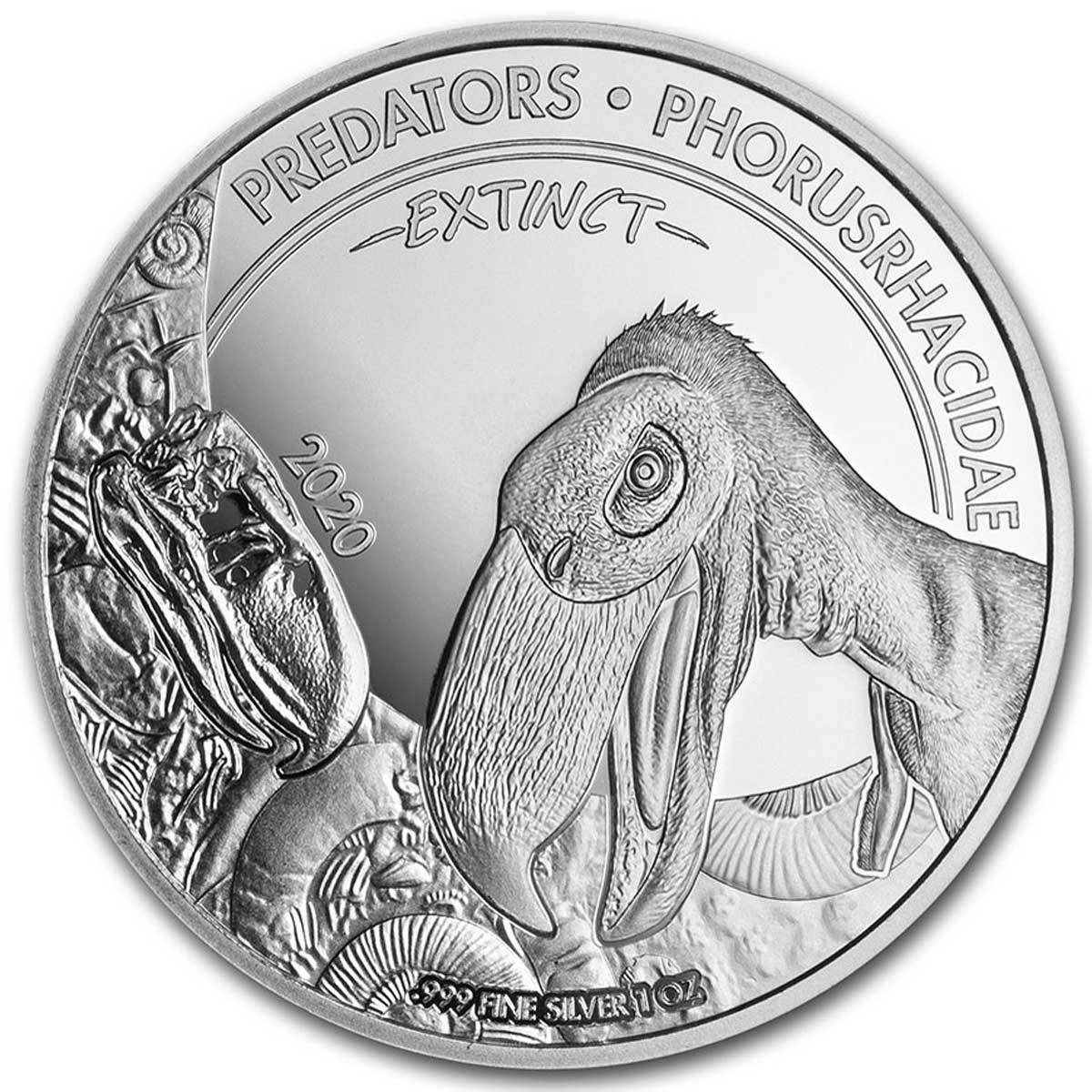
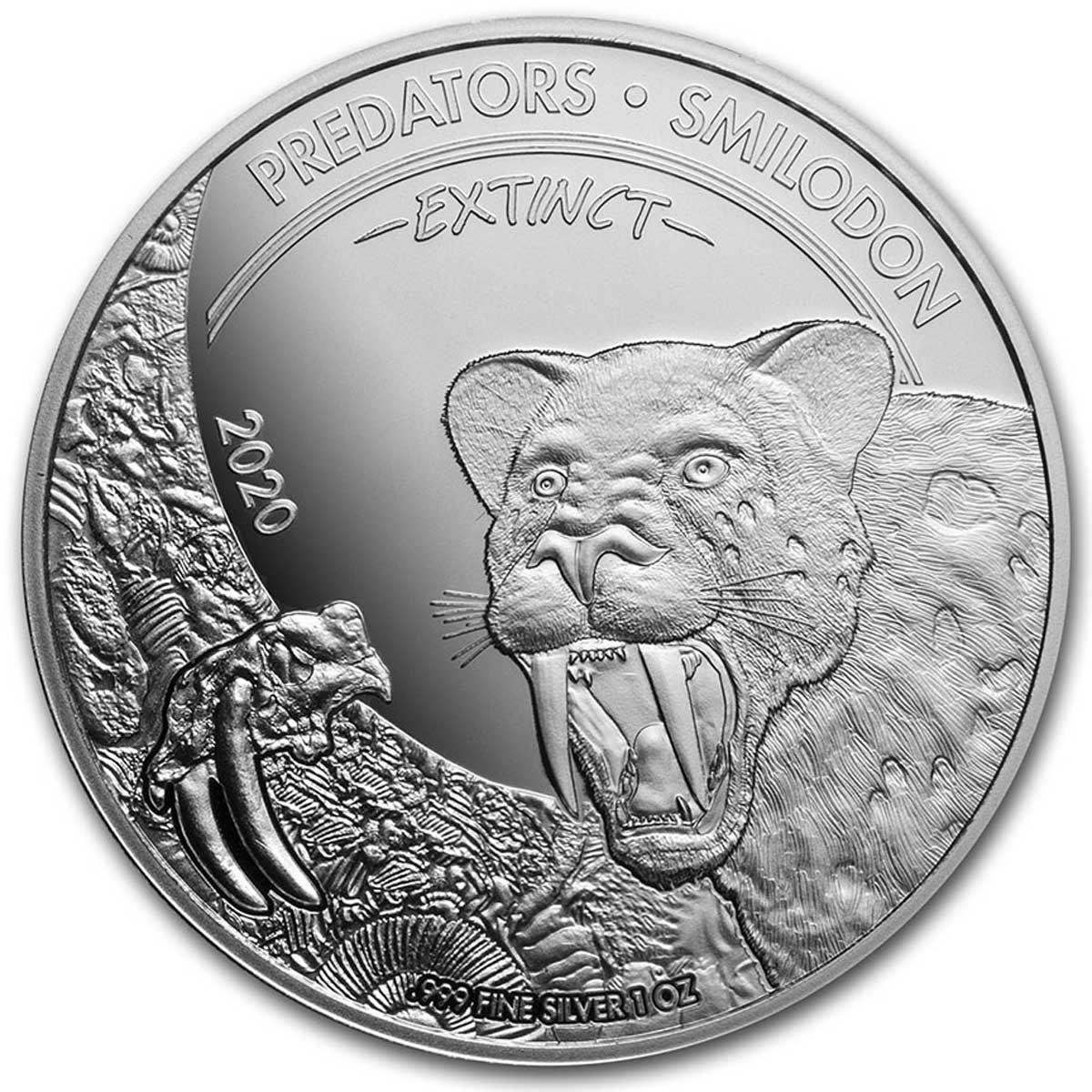
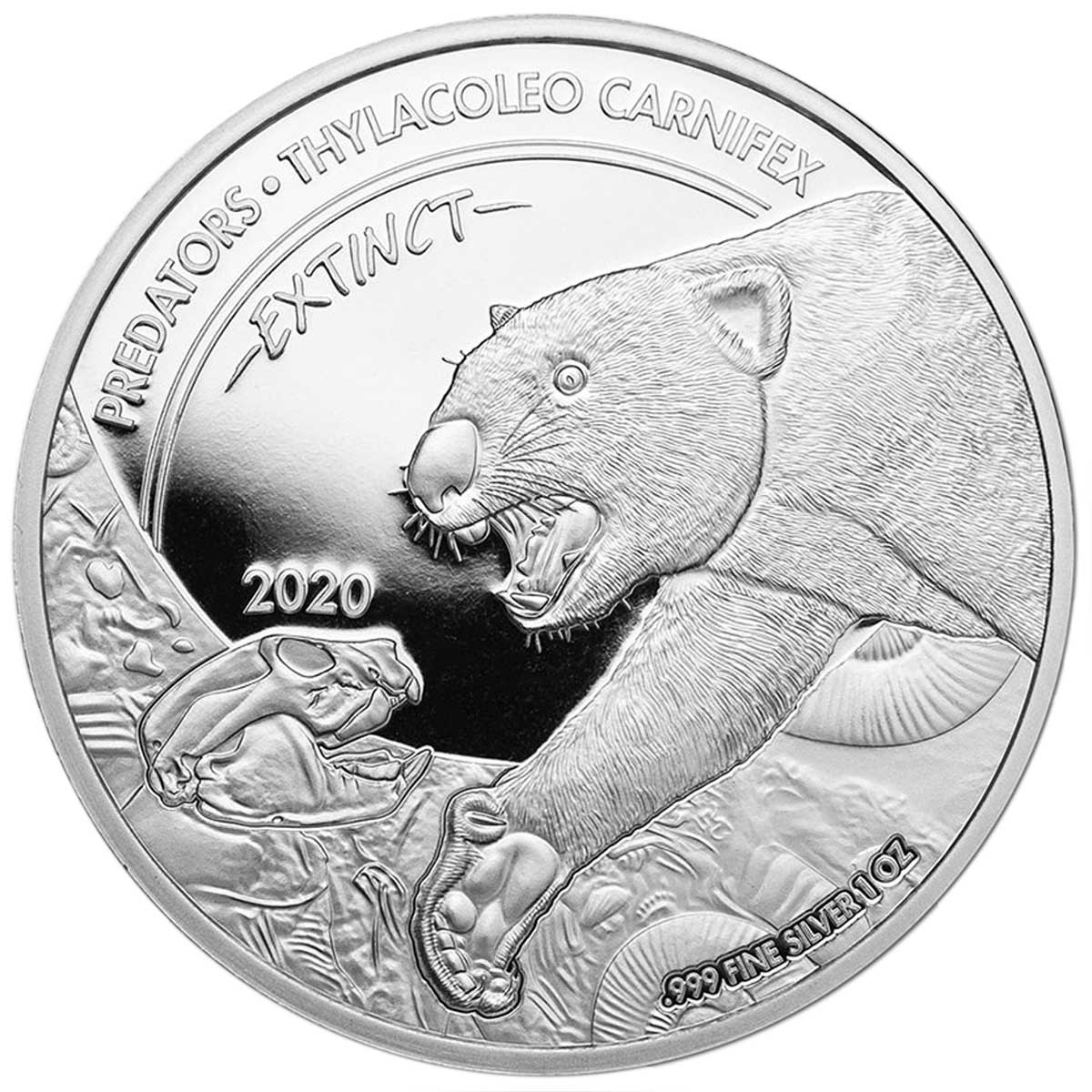

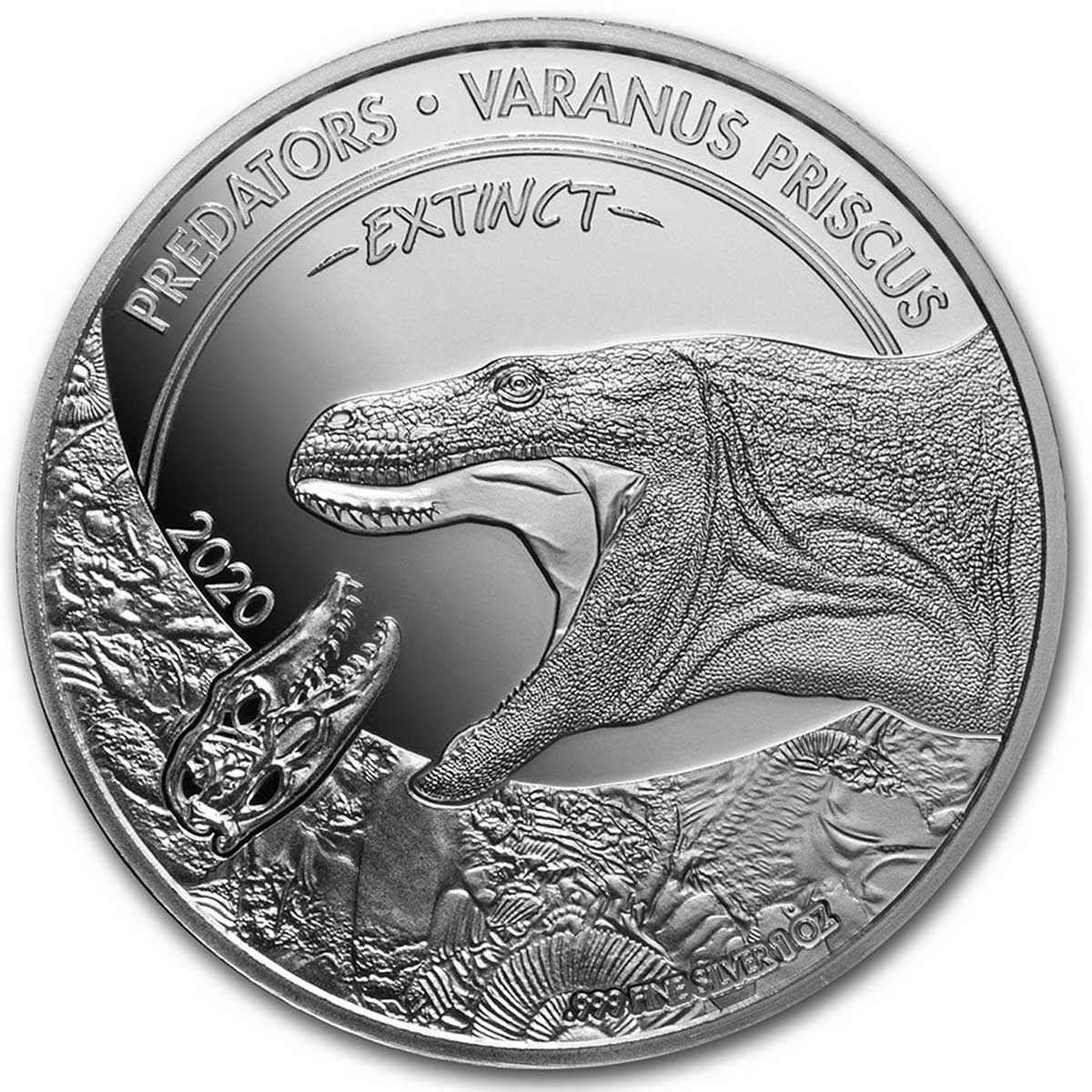

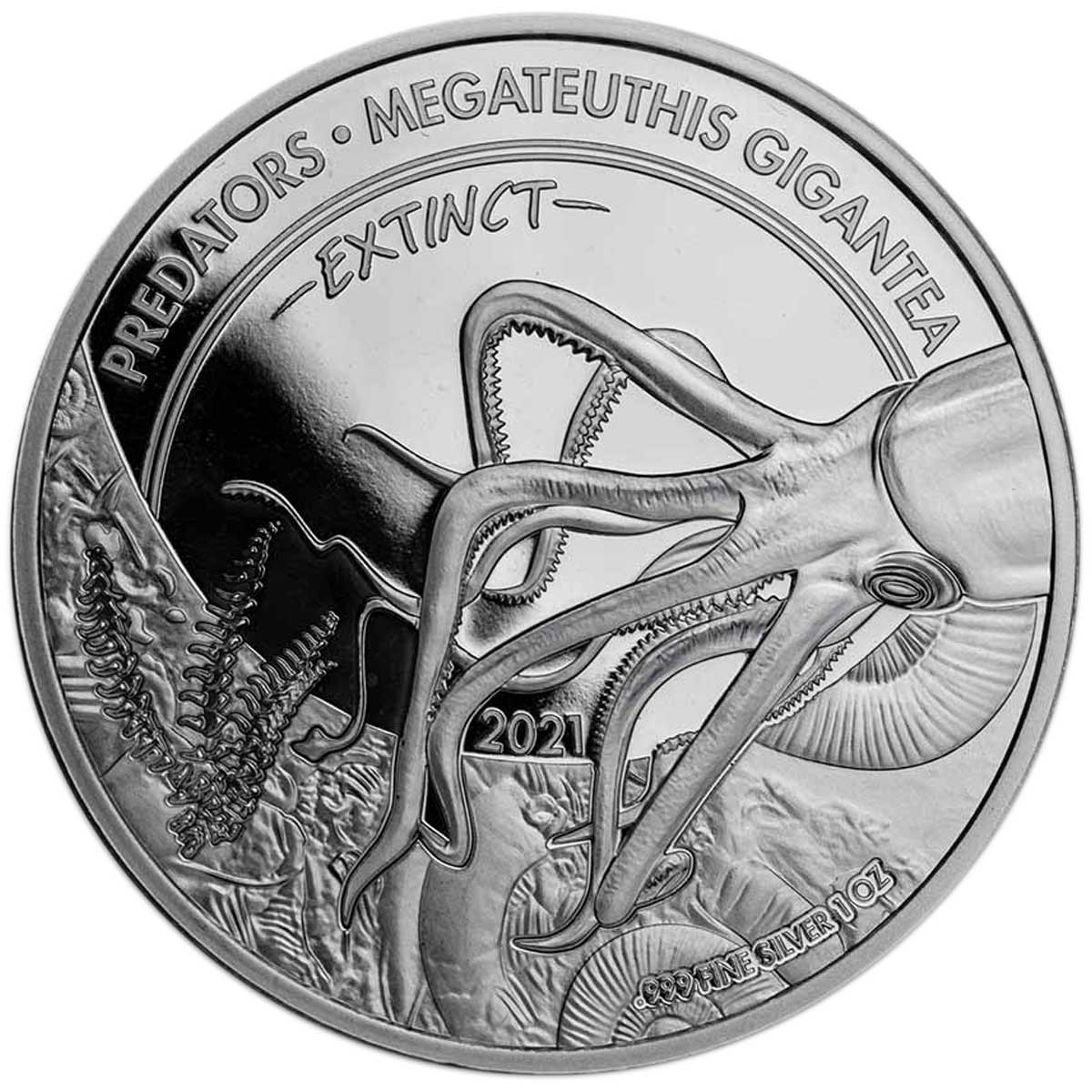
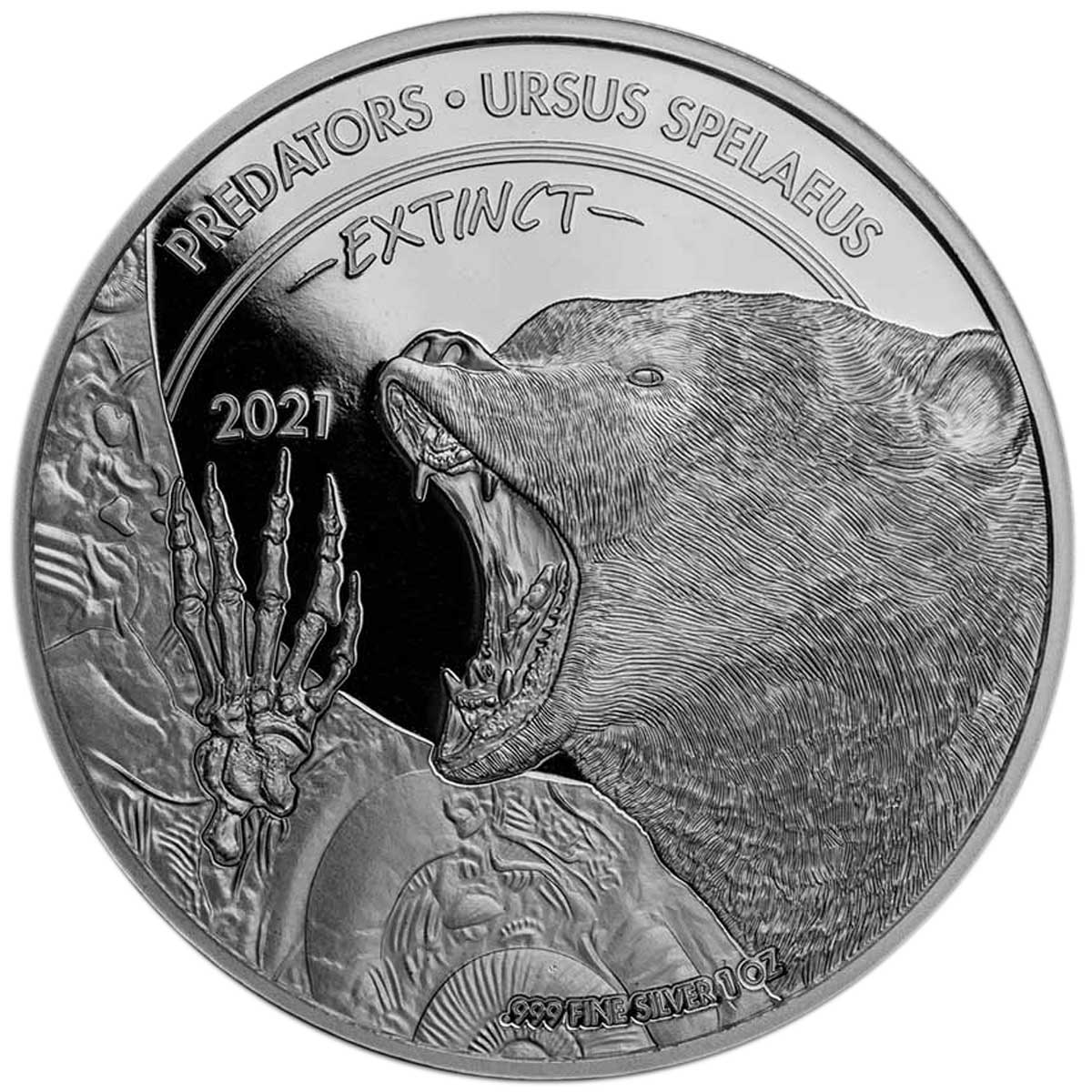

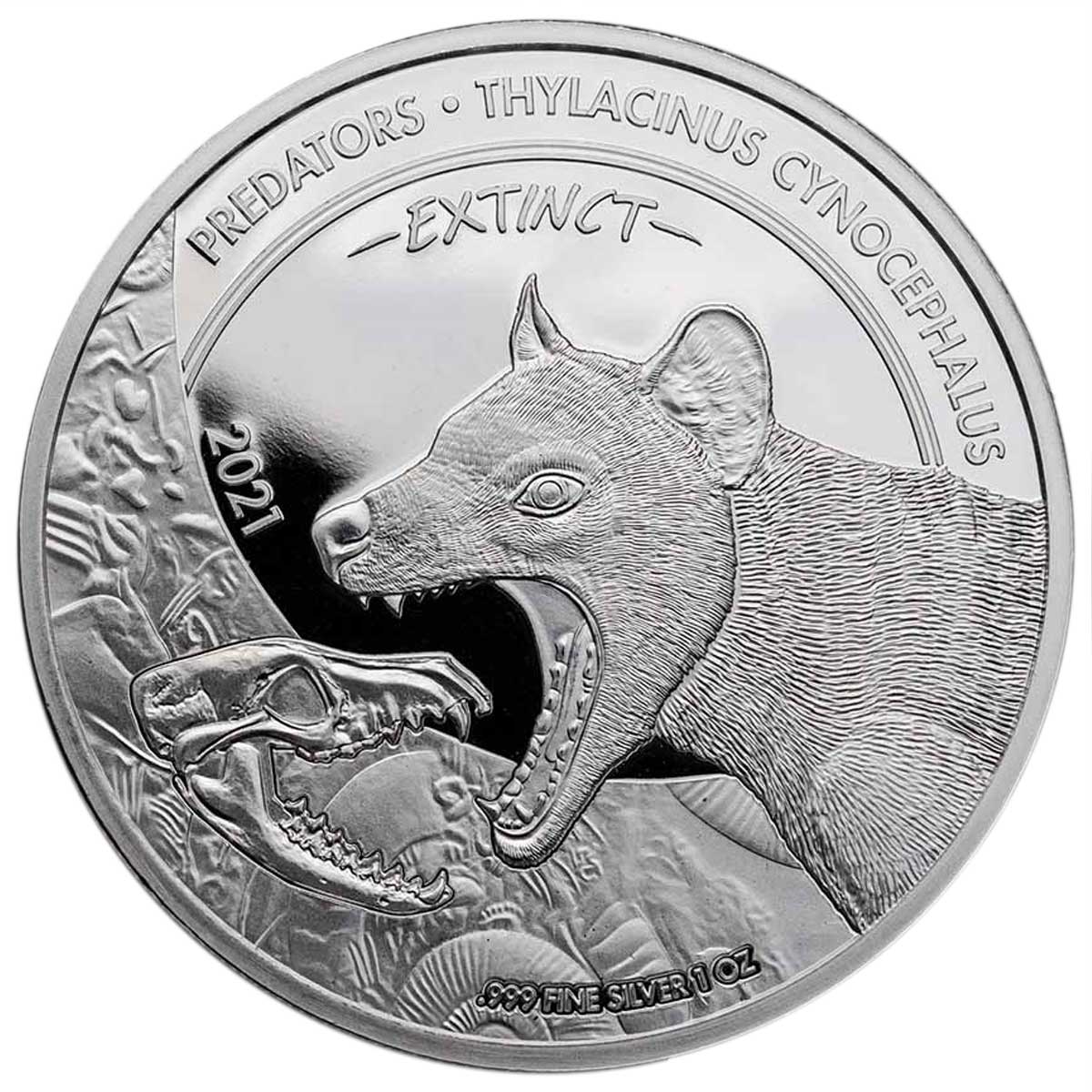
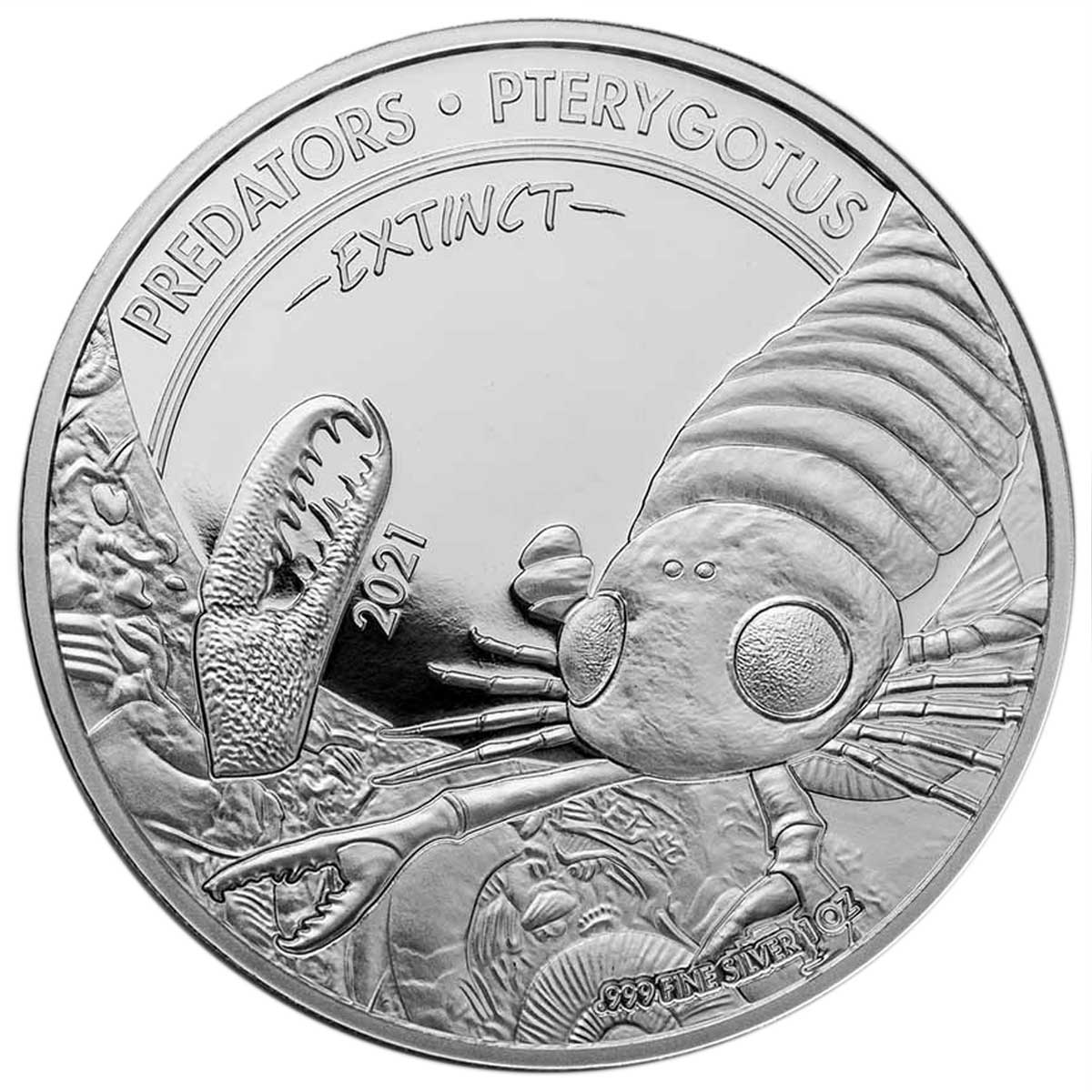

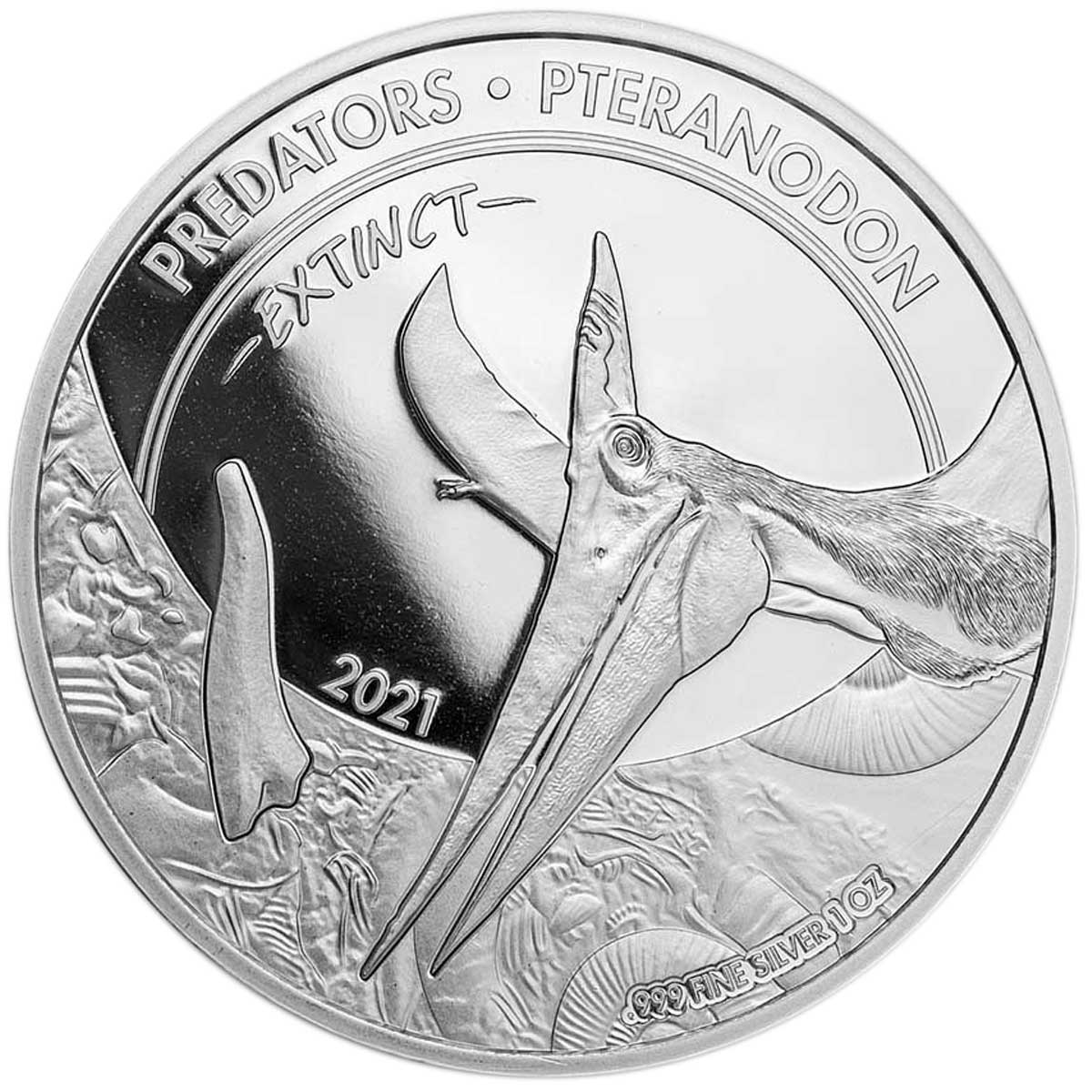

Leave A Comment